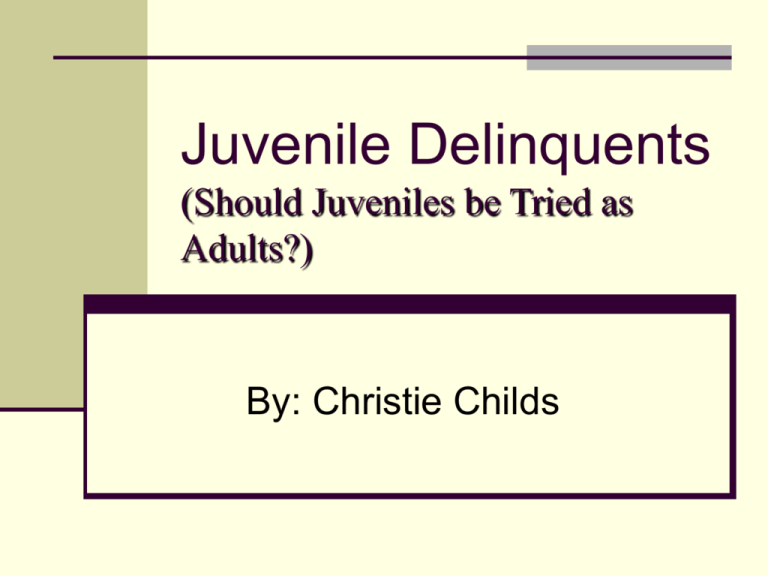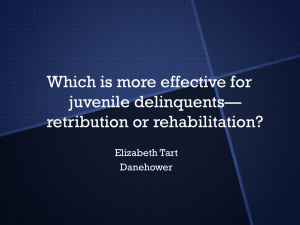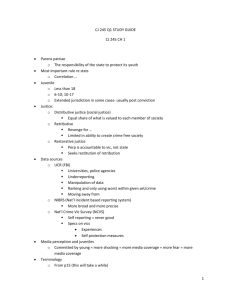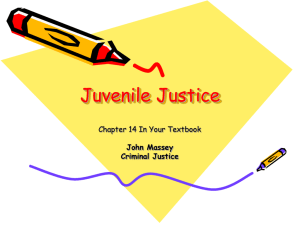Power Point
advertisement

Juvenile Delinquents (Should Juveniles be Tried as Adults?) By: Christie Childs Overview First, the reason for establishing juvenile courts was so that children did not have to associate with the hardened adult criminals or have to be in their institutional at all. Than the reason for separating juveniles and adults was to rehabilitate the child rather than punish them A “young person or juvenile” is defined in s. 2 in the young offenders act, as persons 12 years or more, but less than 18 years Juvenile facilities teach juveniles how to change their life around and be an asset to the community. Overview #2 Juvenile facilities have different programs such as the Behavioral Modification System, Pod- Based Programs, Cognitive behavioral programs, etc. “Restoration justice is based on the assumption that none of the essential functions of the justice system-rehabilitation, community protection, sanctioning, and victim restoration-can be effectively accomplished without the joint involvement of victims, offenders, and the community. It is based on the belief and value statement that justice is best served when victims, offenders, and the community receive balanced attention and gain tangible benefits from their interactions with the juvenile justice system.” Questions What age should youth delinquents be tried as adults? What is the purpose for building juvenile facilities? Are juvenile facilities too harsh or too lenient? Is juvenile crime rising because juvenile facilities are too lenient? Does the Behavior modification system help youth reinforce appropriate behavior? Should our tax money be spent on helping juvenile delinquents rehabilitate? Thesis Juveniles shouldn’t be tried as adults because age appropriate facilities allow juvenile delinquents to be protected, juvenile court processions are age appropriate, and the rehabilitation in age appropriate facilities benefits society. Argument #1 Age appropriate facilities allow juvenile delinquents to be protected. “The reason for establishing juvenile courts was so that children did not have to associate with the hardened adult criminals or have to be in their institutional at all.” “ All residents are in classes appropriate to their age level and/or cognitive functioning, including middle school, and GED education” Argument #2 Juvenile court processions are age appropriate “For the serious cases, the next step is for the city’s legal department to file a formal petition, a statement of charges, which present the case against the child. Than the department sets a date or the hearing which is an informal sort of trail. The judge might decide to let the juvenile be released to his or her family until the hearing is scheduled. If the charges are serious the judge might decide to have the child be detained and sent to temporary residence facilities for young offenders” “Less serious cases go directly to a fact-finding hearing, which is less formal than a trial but involves a lawyer for the juvenile.” Argument #3 The rehabilitation in age appropriate facilities benefits society. “Behaviour management system: 1) Ignore (ignore other inappropriate behaviour, focus on current task, avoid distraction) 2)Talk ( effectively articulating what the resident knows in group and classes; appropriate use of language, such as no inappropriate, talk or Swearing. 3)Cooperate/Participate ( follow all directives and expectations, help out, and take initiative) 4) Area ( rooms are orderly and neat; residence have prepared materials for group and class; homework is done) 5) Gestures ( no gang signing, inappropriate touching; good touching, e.g. patting on the back, shaking hands when meeting someone new and introducing oneself)” “Residents receive weekly behavioural goals, which are evaluated three times per day.” Counter-arguments If a person is old enough to know a certain action is wrong, and still does it he/she should suffer the full consequences? The court is failing to protect society from youthful crimes. In many cases the juvenile facilities are doing more harm than good for the young offenders. True Story JL, who is 17 was released in May. He completed his GED ( obtaining a nearly perfect score), is working several jobs, and is registered at College of Dupage. He has a long history of crime and incarceration, including in the state of California. “When I came to the detention center, my family wrote me off. I had no family. I had nothing. In California, when I was locked up, I was treated like an animal. No one asked me how I was doing. I came to the Dupage detention center. The staff became like family to me. They asked how they could help me. They showed me positive things about myself. They taught me skills: How to look at my behavior; how to make changed in my life; how to think positively. I was able to take pride in myself for the first time. The detention center taught me how to be successful.” Work Cited Albert R. Roberts, Juvenile Justice Sourcebook, New York: Oxford University Press, (2004) Anothony N. and Carla Cesaroni, Responding to Youth Crime in Canada, Toronto: University of Toronto Press, 2004/ Barry Krisberg, James F.Austin, Reinventing Juvenile Justice, Unitied States: Sage Publications, inc. (1993) Carney, Dan. “Get Tough' juvenile crime bill approved by Senate panel.” TOPICsearch.http://search.ebscohost.com/login.aspx?direct=tru e&db=tth&AN=9709102099&site=ehost-live Work Cited D. Owen. Justice Delinquency in Canada, Concord ON: Irwin Publishing, 1998 Ellen Heath Grinney, Delinquency and Criminal Behavior, U.S: Chelsea House Publishers, 1992 John A. Fraser, House of Commons Debates, Hansard: 1992 Lacayo, Richard, “Teen Crime” http://search.ebscohost.com/login.aspx?direct=true&db=tth&AN =9707161555&site-ehost-live, TOPICsearch Work Cited Nicholas Bala, Youth Criminal Justice Law, Toronto: Irwin Law Inc. (2003) Stephen D. Cook, Young Offenders Act-1991, Vancouver B.C: The continuing Legal Education Society of British Columbia, 1991 Trumbull, Mark, “Trying teens as adults: Not always hard time.” http://search.ebscohost.com/login.aspx?direct=true&db=tth&AN =9508281426&site=ehost-live, TOPICsearch V. Moore, Juvenile Crime, New York: Nova Science Publisher, inc., (2003)





